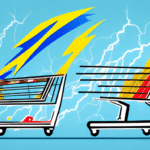How Partner Government Agencies Can Improve Supply Chain Efficiency
Supply chain management is a critical aspect of any organization that deals with the acquisition and delivery of goods and services. Partner government agencies play a crucial role in supply chain management, as they are responsible for procuring and distributing materials needed by various departments. However, the current state of supply chain efficiency in government agencies is often unsatisfactory, with excessive delays, cost overruns, and lack of transparency. In this article, we will explore the key challenges faced by partner government agencies in supply chain management and examine best practices for addressing them to achieve improved supply chain efficiency.
Understanding the Role of Partner Government Agencies in Supply Chain Management
Partner government agencies act as intermediaries between suppliers and users of goods and services. They are responsible for procuring materials required by various departments and distributing them efficiently. Partner government agencies are expected to ensure that procurement is conducted in a fair and transparent manner, without compromising quality or value for money. This involves:
- Identifying reliable suppliers
- Ensuring compliance with procurement rules
- Negotiating contracts that meet the needs of various departments
In addition to procurement, partner government agencies also play a crucial role in managing the supply chain. This includes overseeing the transportation, storage, and distribution of goods and services. They must ensure that products are delivered on time and in good condition, while also minimizing costs and reducing waste. Effective coordination with suppliers, logistics providers, and other stakeholders is essential for achieving these goals.
Partner government agencies also have a responsibility to monitor and evaluate the performance of suppliers and service providers. This involves conducting regular audits and inspections to ensure that they are meeting the required standards and complying with contractual obligations. If any issues are identified, partner government agencies must take appropriate action to address them, which may include terminating contracts or imposing penalties.
For more insights on government procurement best practices, visit ShipScience Procurement Insights.
Analyzing the Current State of Supply Chain Efficiency in Government Agencies
The current state of supply chain efficiency in government agencies is highly variable. According to a 2023 Supply Chain Efficiency Report, many agencies are struggling to keep pace with the increasing demands for goods and services, resulting in delayed delivery and increased costs. The lack of integration and coordination between different departments is often a major obstacle to efficient supply chain management. Furthermore, the lack of transparency and accountability in procurement processes contributes to inefficiencies and corruption.
One of the key challenges facing government agencies is the complexity of their supply chains. With multiple stakeholders involved in the procurement process, it can be difficult to ensure that everyone is aligned and working towards the same goals. This can lead to confusion, delays, and errors that significantly impact supply chain efficiency.
Another issue that government agencies face is the need to balance cost savings with quality and reliability. While it is important to keep costs down, agencies must also ensure that they are procuring goods and services that meet their needs and are of sufficient quality. This balancing act requires careful planning to avoid cutting corners or sacrificing quality in the pursuit of cost savings.
Identifying Key Challenges in Supply Chain Management for Government Agencies
There are several key challenges faced by partner government agencies in supply chain management:
- Lack of Integration and Coordination: This results in duplication of effort, delays, and ineffective use of resources.
- Lack of Transparency and Accountability: This can lead to the award of contracts to unqualified suppliers or the payment of inflated prices.
- Limited Use of Technology and Data Analytics: Without modern tools, agencies struggle to optimize their supply chains.
- Shortage of Skilled Personnel: Attracting and retaining qualified supply chain professionals remains a significant hurdle.
- Increased Complexity of Global Supply Chains: Navigating international regulations, cultural differences, and logistical challenges adds layers of difficulty.
Addressing these challenges requires a multifaceted approach that includes adopting new technologies, improving training programs, and fostering better inter-departmental communication.
Leveraging Technology to Improve Supply Chain Efficiency for Partner Government Agencies
The use of technology is essential for improving supply chain efficiency for partner government agencies. Key technologies include:
- Electronic Procurement Systems: These systems enable more efficient and transparent procurement processes.
- Data Analytics: Analyzing procurement and supply chain data helps agencies make informed decisions. According to the ShipScience Data Analytics Study, agencies that utilize data analytics have seen a 20% improvement in procurement efficiency.
- Mobile Devices for Tracking: Mobile technology allows for real-time tracking of shipments and inventory.
- Blockchain Technology: Blockchain provides a secure and transparent way to track and verify transactions, helping to prevent fraud and improve accountability.
- Artificial Intelligence (AI): AI can analyze large datasets to identify patterns and trends, aiding in better forecasting and problem detection.
Implementing these technologies can streamline operations, reduce manual errors, and enhance overall supply chain performance. For more information on technology solutions, visit ShipScience Technology Solutions.
Implementing Best Practices for Effective Supply Chain Management in Government Agencies
Partner government agencies can adopt several best practices from the private sector to enhance supply chain efficiency:
- Adopt a Comprehensive Supply Chain Management Framework: Integrate different departments and processes within a unified framework that includes performance metrics and targets.
- Vendor Management Programs: Ensure supplier reliability through consistent performance monitoring and evaluation.
- Collaborative Partnerships: Establish strong partnerships with suppliers to foster innovation and solve common challenges.
- Green Procurement Practices: Implement environmentally sustainable procurement methods to reduce the environmental impact.
- Technology Integration: Utilize automated systems for inventory management, order processing, and shipment tracking to streamline operations.
By leveraging these best practices, government agencies can achieve greater efficiency, cost savings, and improved service delivery. Detailed guidance on best practices can be found in the ShipScience Best Practices Guide.
Addressing Compliance and Regulatory Issues in Partner Government Agency Supply Chains
Compliance with regulatory and ethical standards is paramount for partner government agencies. Key considerations include:
- Regulatory Compliance: Adhere to regulations related to goods procurement, environmental standards, and labor laws.
- Ethical Labor Practices: Ensure suppliers provide fair wages and safe working conditions.
- Environmental Impact: Implement strategies to reduce waste and promote sustainability within the supply chain.
Addressing these issues requires meticulous planning, continuous monitoring, and collaboration with regulatory bodies. Agencies can refer to the ShipScience Compliance Resources for comprehensive guidelines.
Creating Collaborative Partnerships to Enhance Supply Chain Efficiency for Government Agencies
Collaborative partnerships between partner government agencies and suppliers can significantly enhance supply chain efficiency. Effective collaboration involves:
- Joint planning and forecasting
- Shared inventory management
- Exchange of information and data
- Negotiation of favorable contract terms
Such partnerships foster innovation and facilitate the development of solutions to common challenges, leading to streamlined processes, cost savings, and improved service delivery to the public. Building trust and strong relationships with suppliers ensures long-term, sustainable partnerships. Learn more about fostering collaborative partnerships at ShipScience Collaboration Strategies.
Measuring and Tracking Key Performance Indicators (KPIs) for Improved Supply Chain Efficiency
Measuring and tracking Key Performance Indicators (KPIs) is essential for achieving improved supply chain efficiency. Essential KPIs include:
- Delivery Lead Time: The time taken from ordering to delivery of goods.
- Inventory Turnover: The rate at which inventory is used and replenished.
- Supplier Performance: Evaluation of suppliers based on quality, reliability, and compliance.
- Cost Savings: Reduction in procurement and operational costs.
Regularly monitoring these KPIs allows agencies to identify areas for improvement, make informed decisions, and track progress towards performance targets. Tools and resources for KPI tracking can be found at ShipScience KPI Tools.
Realizing the Benefits of Improved Supply Chain Efficiency for Partner Government Agencies
Improving supply chain efficiency offers numerous benefits for partner government agencies, including:
- Reduced Costs: Streamlined processes and better negotiations lead to significant cost savings.
- Improved Delivery Times: Efficient supply chains ensure timely delivery of goods and services.
- Increased Transparency and Accountability: Clear processes reduce corruption and enhance trust.
- Enhanced Compliance: Adherence to regulations and ethical standards mitigates legal risks.
- Better Stakeholder Satisfaction: Efficient services lead to improved public perception and satisfaction.
These improvements not only benefit the agencies internally but also enhance their ability to serve the public effectively. For a detailed overview of benefits, visit ShipScience Benefits Overview.
Case Studies: Successful Examples of Improved Supply Chain Efficiency in Government Agencies
Numerous government agencies have successfully enhanced their supply chain efficiency through strategic initiatives:
- United States Department of Defense: Implemented electronic procurement systems, performance-based logistics, and lean supply chain principles, resulting in significant cost savings and improved performance. More details can be found in the US Defense Case Study.
- Government of Canada: Adopted a comprehensive supply chain management framework that integrates procurement and logistics functions across different departments, leading to enhanced efficiency and coordination. Read the full case study here.
These case studies illustrate the tangible benefits of adopting best practices and leveraging technology in supply chain management.
Future Trends and Innovations in Partner Government Agency Supply Chain Management
The future of partner government agency supply chain management is poised to be influenced by several emerging trends and innovations:
- Increased Use of Blockchain: Enhances transparency and data security within the supply chain.
- Adoption of Circular Economy Principles: Focuses on reducing waste and promoting sustainability.
- Predictive Analytics: Improves forecasting and inventory management through advanced data analysis.
- Artificial Intelligence and Machine Learning: Automates decision-making processes and identifies potential issues proactively.
- Internet of Things (IoT): Enables real-time tracking and monitoring of goods throughout the supply chain.
These trends are expected to drive more efficient and effective supply chain management practices, enabling government agencies to better respond to future challenges. Stay informed about the latest innovations at ShipScience Future Trends.
In conclusion, partner government agencies play a critical role in supply chain management, and improving supply chain efficiency is essential for achieving better outcomes for stakeholders and the public. By addressing key challenges, leveraging technology, implementing best practices, and creating collaborative partnerships, partner government agencies can realize the benefits of improved supply chain efficiency, reduce costs, improve delivery times, increase transparency and accountability, and enhance their ability to meet the needs of their stakeholders.
```




















